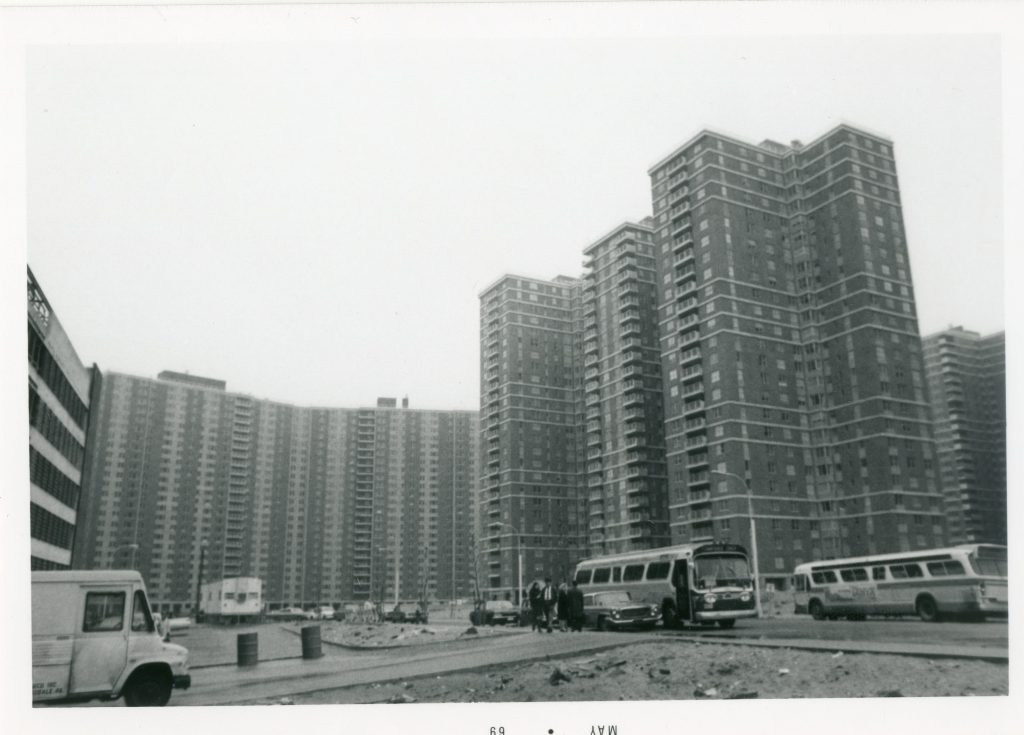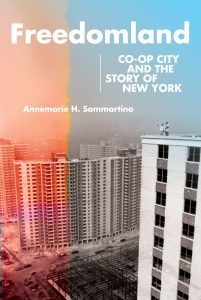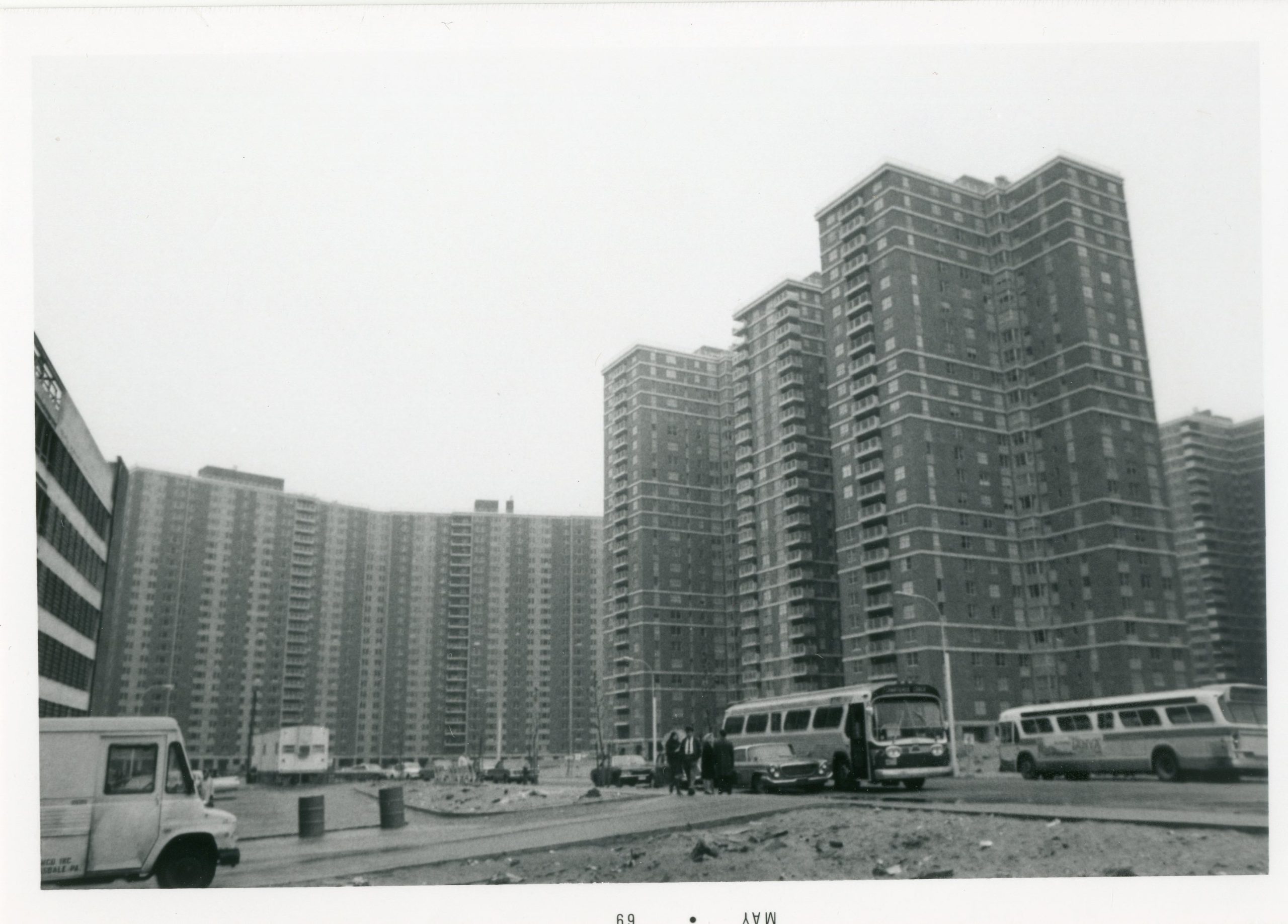
Co-op City is the largest housing cooperative in the country. Photo courtesy of Annemarie Sammartino
Affordable housing activists spend a lot of time talking about how to bring about solutions that match the scale of the problem. Co-ops and community land trusts—frequently mentioned strategies for creating permanently affordable housing—often face challenges about their potential to scale up.
It seems timely, then, that a new book is out about the largest housing cooperative in the country, a development of phenomenal scale and longevity—Co-op City in the Bronx.

Shelterforce spoke with Sammartino about her book, and about what we might learn from Co-op City today.
The transcript below has been edited for clarity and length.
Miriam Axel-Lute: Tell me about how you got interested in writing a book on Co-op City.

Annemarie Sammartino
Annemarie Sammartino: I grew up in Co-op City. My family moved there before I had any memories. I was not interested in writing about that. I was a German historian by training. My first book is on German history, but to write that book, I lived in Berlin for a number of years. When I would describe where I grew up to friends who had never been to Co-op, I would compare it to this neighborhood in East Berlin that looked a little bit like it.
After answering that question a thousand times, I started wondering, “Why do these neighborhoods look so similar? Is there a story there?” I really thought I would just read a book about Co-op City and do some research [on] this development in Germany. But then I couldn’t find a book on Co-op City.
I started doing research and realized there was a much more interesting story than I knew anything about, so I wound up writing the book.
At what point did you realize that you grew up in a very unusual place compared to most Americans?
I don’t think I grew up thinking of it as a particularly unique or special place at all, for a couple of reasons. One is, as I say in the book, Co-op City is designed in a way for ordinary New Yorkers. Basically, the people around you are all ordinary New Yorkers.
I’d heard pieces of [its] history, but very little. The rent strike, for example. My family moved to Co-op City right after the rent strike ended. Growing up, I played with the children of the leaders of the rent strike. I didn’t know about the history [of it], I just knew that it had happened.
What is Co-op City? How did it come to be?
Co-op City is the largest housing cooperative in America, possibly internationally. It’s 15,372 apartments, in a corner of the Northeast Bronx. It was built in the mid-’60s by a group called the United Housing Foundation, [which] was part of this broader push in New York state and New York City to produce not just housing projects for the very poor but affordable apartment housing for the middle class and working class.
The United Housing Foundation has its origins in the Lower East Side. Essentially, we’re talking about communist Jews. The United Housing Foundation builds Co-op City; it’s their largest project and it’s their final project using [Mitchell-Lama] funding from New York State.

The Co-op City application office. Photo courtesy of Annemarie Sammartino
Co-op City is first occupied in the late ’60s but prices wind up rising, and by the mid-1970s, they have what they called a rent strike. Now, in reality, they’re not paying rent, because it’s a cooperative; they own a piece of the development as a whole. Everyone buys in—that’s what they call an equity deposit—and then you pay monthly carrying charges. These carrying charges pay the mortgage, operating expenses, utilities.
This rent strike really is a carrying charge strike; essentially, carrying charges had risen. They were projected to rise up to 250 percent over what they’d been originally projected as.
This rent strike, about 80 percent of the population participated in it. They win resident control of the development away from the United Housing Foundation.
When we think of a co-op, we tend to think of it as being automatically resident-controlled. Why did Co-op City need another step to get there?
The United Housing Foundation [had] two kinds of shares, A shares and B shares. Residents had B shares. The idea was that once they paid off the mortgage, then they would actually control the cooperative completely. There were residents on the board [of] the corporation that technically runs Co-op City, [which is called Riverbay]. But the majority of people on the board—the majority of people making the decisions up until mid-’75—are actually the same people that are on the board of the United Housing Foundation.
The people that lived in Co-op City felt this board was paternalistic and didn’t have the best interests of the residents in mind. Actually, one of the very first things that happened when the rent strike happens is that the resident members of the board quit, saying, “Look, this is just a sham. We’re not actually in control.”
One resident activist says, essentially, “Look, you guys treat us like owners when you want to make us pay more money. You want us to assume more risk and more responsibility, but you treat us like tenants when you just tell us what to do. We basically have the responsibility without the power.”
The idea of cooperative housing was originally to remove this housing from the capitalist housing market. You get this funding from the state and [pay] back that mortgage, and sure that’s capitalist. But within it, you could create an almost socialist space for people in which they shop at cooperative stores, create cooperative institutions—nursery schools, community groups, etc.
Then, because costs are rising and the city and the state are winding up in financial issues, [it] just doesn’t work. Maybe it also wouldn’t have worked just simply because of the size of it. Co-op City is three times larger than any other cooperative that the United Housing Foundation starts. The next largest is Rochdale Village in Queens, but most of their cooperatives are actually quite a bit smaller than that.
The leadership of the United Housing Foundation would later claim that the reason Co-op City winds up having all these problems is that the people that live there don’t take their responsibility seriously enough as owners of the cooperative, and that because it’s too big, they don’t know each other well enough. They don’t have enough of a sense of common purpose.
Do you think that was an accurate assessment?
I don’t. The fact that 80 percent of residents wind up supporting the rent strike tells me that there is a common purpose, it’s just not the same as the United Housing Foundation’s purpose. Now, unity during the rent strike does fracture afterwards. Like many movements, it’s hard to sustain once you don’t have a clear enemy, but I think that you do have this sense of community there. There are several ways in which that community is created, in part, by this clear villain: New York State, trying to raise rates, and the United Housing Foundation.
There’s also a failure to harness it. Once the rent strike ends, the state is not interested in negotiating. They are basically like, “Here, you can have it, you now have resident control, but you still have to pay this mortgage.” They refuse to subsidize. They refuse to negotiate until eventually they’re forced to, in the ’80s.
How did it come to economically stabilize?
A few things happened. When the rent strike ends, Co-op City still has all this debt. Basically, they’re given a year, like, “OK, you figure out how you’re going to pay it.” The state then commissions a bunch of studies [on] “what could we do to make Co-op City economically viable?”
The state wants what they call an economic rent. They want Co-op City to be economically self-sufficient so that [it] would require no ongoing subsidy from the state. There [are] negotiations in the late ’70s into the very early ’80s, that in theory are supposed to put Co-op City on the path to an economic rent. There are people that oppose this; they feel like the increases are too high. At least for a period they’re higher than the increases in rent-stabilized housing, which a lot of people had left to move to Co-op City. There’s anger about that.
In the mid ’80s, three important things happen. One is that the state, and Riverbay, for that matter, realize that there are major construction defects in Co-op City: they have to replace the entire plumbing system—stuff like that. An economic rent that could pay both for the mortgage and these construction defects would soar beyond what anyone could really pay.
The state recognize[s] that they don’t want to push Co-op City too far because they know there could be another rent strike. The rent strike almost caused the bankruptcy of the State Housing Finance Agency. They don’t want that.
Essentially, the state realizes that they’ll have to choose between self-sufficiency and affordable housing. Because of this pressure from the residents of Co-op City who are still very focused on affordability, and because of this memory of the rent strike, and because also, by this point, the state is in a better situation financially than it was in the mid ’70s, they retreat from this hard-line position.
Starting in 1986, the level of increases go down, and Co-op City’s leadership, Riverbay, and New York State start working together a little bit more because they recognize that they’re stuck with each other and recognize the value of having good, livable, affordable housing.
At this point, Riverbay is controlled by a majority of residents?
After 1976, it’s all residents in charge. Now, that’s not to say it’s not incredibly fractious. Residents disagree with each other about all sorts of things, but the one thing that they all do have in common is this desire to guarantee the affordability of Co-op City.
One other thing that’s important… Co-op City is so large that it has [state assembly] representatives [for whom] over 50 percent of the assemblyperson’s constituency is in Co-op City. It’s a little bit less for state senate, but still a significant plurality. Therefore Co-op City has a power in Albany and the state legislature that other developments just don’t have.
There are people willing to advocate for Co-op City at that level [who] can trigger real problems for the state budget in a way that a smaller development can’t. That gives them a kind of leverage that enables that activism to have an effect.
Speaking of that size, that also means that there’s politicking internally.
Elections happen across the cooperative to elect representatives to this Riverbay board. Those representatives make all decisions in theory about the cooperative.
In fact, one of the real issues that they run into when they take power of the cooperative in the late ’70s is that these aren’t people who have experience running an organization this big. The budgets are huge. The learning curve is huge. They’re suddenly like, “Let’s design playgrounds. Let’s fix the laundry rooms. Let’s figure out how we’re going to replace this plumbing system.”
[In] the period that I’m looking at, you have this highly activated community. In the rent strike, a thousand people easily could show up to various meetings. That’s petered out. Now, you have trouble getting a quorum for elections. Fewer people are concerned. Some of that is the pandemic, but even before that, from the mid ’80s, early ’90s-ish, the cost increases have been a lot lower. That force of keeping the cooperative affordable is less animating just because they’ve had to do less to do it. They did that hard work already.
Talk about the affordability. Is it affordable at the same income—not direct levels, but relative levels—as it was when it started?
The median income of Co-op City has been almost exactly the national median income from the time Co-op City was founded until today. You still have to pay an equity deposit to move into the cooperative, but you can finance that. There’s low-cost financing options that are subsidized by the state.
If you want to move into the largest apartment—a three-bedroom—you would pay an equity deposit of a little under $50,000. Again, that’s financeable, and then you pay carrying charges of a little over $1,600 a month. To put that in comparison, the median rent in Manhattan right now, is $4,000 a month. The average is over $5,000 a month. That’s for all sizes of apartments. What I’m talking about here are the largest apartments.
Co-op City has a waitlist. It’s had a waitlist for almost its entire existence, simply because it really is affordable; those carrying charges include utilities, including central air conditioning. They’re big apartments. Even the the smallest apartments are three pretty nice-sized rooms. Co-op City is a really good deal aside from the fact that it’s in the North Bronx, [so] it’s hard to get to a lot of places. These aren’t just good apartments for affordable housing. These are good apartments.
Did the vision of having cooperative businesses pan out?
[In] the original vision of Co-op City, there were three main shopping centers within the development. I remember when I was very little, most of them I think were a cooperative business. The grocery store was definitely a cooperative grocery store. There is still an Amalgamated Bank.
As Co-op City was looking to basically get more money without necessarily raising costs for residents, they started raising rents for businesses. What you start seeing is those cooperative businesses leaving and then other businesses coming in, more chain stores.
The other thing that happened in the late ’80s was that this big mall, Bay Plaza—anyone who’s been to the North Bronx or lower Westchester has at least gotten caught in Bay Plaza traffic—gets built, and then gets expanded over time. Some of the revenue does go to Co-op City, but it was developed by a private developer; it was never intended to be a cooperative space.
These early shopping centers—you have the cooperative optical store, the cooperative grocery, the cooperative butcher—they’re called community centers. You have the stores, but then you also have all of these meeting rooms underneath them, in the basement. They are also in the buildings. Most of Co-op City are these huge towers, and they all have meeting rooms in them.
I remember going to children’s birthday parties in these. The idea was that this could be a space where people could come together for all sorts of community reasons. At least at first, the United Housing Foundation would publish these lists of all the community organizations and co-ops, and that was a sign of the health of the community in their minds.
Are those community rooms still there?
They’re still there. I think they’re used, but less so than in decades past.
You mentioned this idea of removing housing from the market. How much has Co-op City been successful in insulating itself from market forces?
It’s a great question. To get an apartment in Co-op City, you pay this equity deposit and then you pay these carrying charges, and then when you leave, you get back whatever the equity deposit is at that point. Essentially, you’ve bought a share and then you get your share back.
During the ’60s, during the ’70s, New York City housing is often in pretty atrocious shape, apartments are cheap to buy, but it’s unclear if they’re going to gain any value. Co-op City is secure. The rate of increase of the equity deposit is not based on the market rate.
But in the late ’80s, New York is recovering, the housing market is going up, middle class people who can afford this equity deposit also have the choice of buying in the city or in the nearby suburbs. Buying starts looking more attractive as the housing market looks like a good investment. By the early ’90s, Co-op City is facing a vacancy crisis because not enough people want to move into the development. What everyone says is “It’s not a good investment.”
The state winds up coming in and essentially negotiating with Riverbay, and they wind up lowering the equity deposits, making them fully financeable. People start moving in.
One issue I’ve heard people say is that if you want to move out you’re almost starting from scratch because you’re going to get your equity deposit back but that’s not enough. Often because of repairs that need to be done to the apartment or whatever you’re not going to get that much back. That continues to be an issue there.
[RELATED ARTICLE: A Low-Cost Ownership Oasis in a Desert of Apartment Unaffordability]
It’s impossible even for a large cooperative in the United States to be fully separated from capitalism. What you’re watching here though is a way in which capitalism is almost dampened, and while you’re in it, it’s less powerful. Aside from the initial decision to move in or potentially move out it’s not motivating decisions in the same way that it might in other kinds of housing.
We need more affordable housing in this country, clearly, and by many assessments, more housing in general. What do you think about Co-op City [as a] model for looking at our housing supply questions?
I think one important lesson from Co-op City is that you put people in a space, there is a community simply because you have people there. What that community looks like may be different—you can influence it in certain ways—but architecture is not a huge influence. In fact, in some ways, the towers wind up being really conducive to community because you have all these people standing around waiting for elevators all the time.
Is this cooperative financing model a good one? I think that in some ways it is, in particular, Mitchell-Lama housing, which essentially operated as a subsidy to developers. It would say, “Here, you can have these low-cost loans but all of these apartments need to go to people that meet these certain income qualifications, so they’re not going to be market rate.” You have to keep your rates low and then you get to build more cheaply.
Co-op City shows that that doesn’t guarantee affordability. We know because [the] rent strike in the mid ’70s tells us that the model alone doesn’t do everything. What it also tells us is that the other features you need are engaged residents, and you need ongoing investment on the part of government entities. It’s not simply something where you subsidize developers and then you’re done.
It does require a community investment—and by community, I mean both within the development and beyond the development—in order to sustain affordable housing. I think that sometimes when people think about affordable housing there’s a tendency [to say], “Well, what’s the funding mechanism? How do we get these things built?” What needs to be recognized is, it’s not just [that] you build it, people move in. You want it to have longevity, you want people to feel a sense of community, you want people to get a sense of safety.
If you ask “What do you want your house to be?” or “How do you think about your house?” the words people use [are] “safety,” “security,” “love,” all those sorts of things. They’re not talking about speculation or profit center even if in America most people are living in a house that they do think of as an investment. For it to have that emotional valence of providing people with security and stability and community requires ongoing investment and ongoing attention to not just building the housing, but also maintaining it.
I think this is a particular model that states and cities got scared of in the mid ’70s by the spectacular collapse of the New York City social welfare model. Co-op City shows that that investment can actually bear fruit over time. What might have looked like this spectacular failure in the mid-’70s, viewed from the perspective of 2022, seems almost this shocking success story.
That’s a really good point. Just to clarify, is there still an income restriction for moving into Co-op City?
There is. There’s a minimum and a maximum. If [once you move you in] you earn above a certain amount, you have to pay a subsidy. Also to be on the waiting list for a Co-op City apartment, you have to show that your income qualifies you to live there.
These income qualifications, they’ve gone up over time. The maximum income for four or more residents in that three-bedroom apartment is $167,000 a year. We’re talking about a middle that’s reaching pretty high into the middle class, but still, living in New York, even earning that much, you could easily have a problem finding affordable housing somewhere else.
Indeed. You’ve mentioned race and the multiracial nature of Co-op City a couple times. Co-ops in other parts of the country actually had difficulty getting financing when they intentionally wanted to be multiracial in the mid-20th century. Tell us a little bit more about those dynamics.
There isn’t a problem necessarily with getting financing, in part because we’re talking about state financing rather than local banks. Because everyone is theoretically all middle class, they all have the money for this equity deposit, it’s seen as a nonthreatening way to create an integrated community.
[RELATED ARTICLE: The Cooperative Struggle Against Redlining]
What the United Housing Foundation wants is a community that is economically homogeneous, but racially integrated. What does that mean? They’re willing to advertise in the Black press, in the Spanish-speaking press, but they’re not willing to change the income requirements in any way to make it available to a wider range of incomes.
The city government, which is in charge of some pieces of this, is pushing the United Housing Foundation to be more economically diverse, in part, because they see it as a way of achieving more racial diversity. The United Housing Foundation pushes back on this. When Co-op City opens, it [has] very similar demographics to New York City, if anything maybe slightly less white than New York City as a whole, but it is very economically homogeneous. This winds up creating a different dynamic than other places in the city.
Is there anything else that we didn’t touch on that you think is really important for people to know about Co-op City?
Co-op City has been reviled in a lot of places because it’s blamed for the decline of other parts of the Bronx. The story goes that Co-op City starts soliciting applications in the late ’60s and basically all of these Jews in the West Bronx abandon their neighborhoods and those neighborhoods decline because those people want to move to Co-op City because they didn’t want to live with Black and Hispanic people.
It is indeed true that a lot of the people that first moved to Co-op City are Jews from the West Bronx, in particular, the neighborhoods around the Grand Concourse. In many ways, their moving is motivated by a degree of racism. They’re watching crime rising. They are watching drugs becoming a bigger issue. They are conflating that with the fact that it’s also becoming more Black and Hispanic.
[But] many of the same people who leave the West Bronx because they feel like the neighborhood is declining move to Co-op City and then are happy to live in what they see as a multicultural community.
It’s really complex and contradictory in a lot of ways.
But sometimes that gets used to [imply] that there’s a zero-sum game when it comes to affordable housing—you think this affordable housing is good, but you’re going to destroy these other communities. I think that that’s an important thing to think through: When is that actually happening? When is that not actually happening? How can we create affordable housing on a scale that we need in this country while also understanding that it will potentially have effects on other communities?
Co-op City is a useful experiment to use to think through affordable housing, both the positive dynamics of it, the things that worked well, but also things that maybe didn’t work well. Not to use as an excuse not to build affordable housing, but rather as a way of recognizing the absolute necessity of affordable housing and then thinking through how to make that happen in the most equitable way possible.
Thank you.






I have just finished reading Annemarie H. Sammartino’s study of the Middle – Income Co-op “Freedomland,” in the Northeast Bronx. As a child of Co-op City Prof. Sammartino’s research was diligent, heartfelt, and thorough. Her case on behalf of grand visions and projects as opposed to Jane Jacobs’ overzealous assertion that small scale “unplanned” neighborhoods trump the projects every time is well taken and sincere.
As Sammartino states there were always kids outside to play with. This factor also makes community and has been articulated to me by quite a few residents of New York City Housing Projects. The mere size of Co-op City (35 towers and over 200 town houses), caused the State to realize the importance to subsidize Co-op City even when major capital improvement projects were needed and the mortgage came due. (With N.Y.C. real estate becoming too expensive Co-op City housed a great many citizens who would have had to move far out into the suburbs. In some ways it was too big to fail.
We owe a debt of thanks to Prof. Sammartino for putting the positions of state improvement spending, as opposed to small scale development into prospective. Both approaches are needed